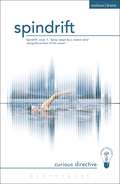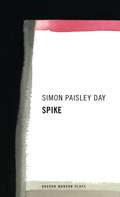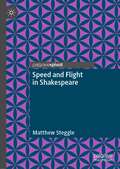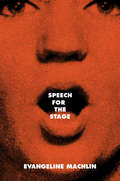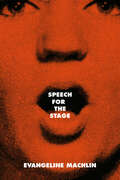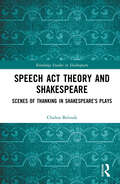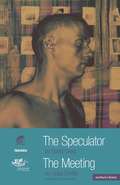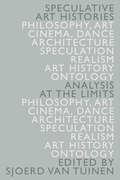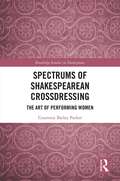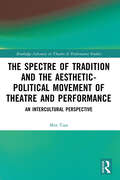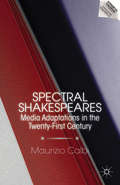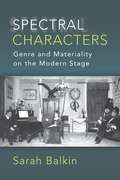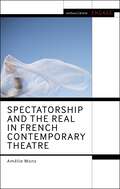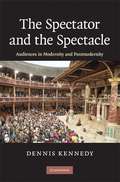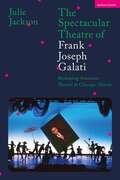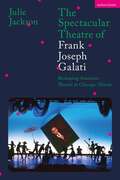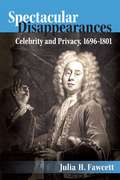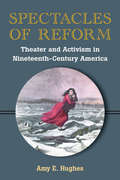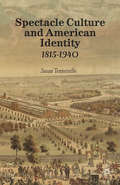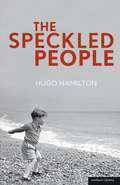- Table View
- List View
Spindrift (Modern Plays)
by Curious Directive–Quantum mechanics is one of those topics that's always just there in a like a super 'I'm so clever' conversation about the grey areas of science. You know, two places at once, walk through walls kind of stuff.–It's attractive-–It's attractive because it's so spooky.In a cold converted garage by the sea, a science podcast troupe rehearse their next episode. Spindrift follows three sisters as they untangle what happened to their father when he disappeared whilst sailing around the world, 20 years ago.A mysterious, heart-breaking triptych, Spindrift traces the invisible waves orchestrating the boundaries of the natural world and examines family, endurance and the paths we choose. Two-time Fringe First-winning, curious directive tell their story with trademark visual storytelling with 3D animation, video projection and motion capture technology. Spindrift is a life-affirming story for anyone who has sat on the shore and stared out to sea for hours on end.
Spike (Oberon Modern Plays)
by Simon Paisley DaySunday. July, 2001. Hendon, centre of the world. A car salesman, alone in the showroom, performs an intimate act of love and worship. Pigeon, crashing through the plate-glass window, witnesses everything. This almighty puncture is the beginning of the big end. Worlds collide. Lives swerve and skid. A pile-up of secrets, sex and sabotage. Can the immaculate bodywork remain undented? And who’s ultimately behind the wheel? An explosive black comedy which opened at the Nuffield Theatre in 2001, starring Richard Briers.
Speed and Flight in Shakespeare
by Matthew SteggleShakespeare's plays are fascinated by the problems of speed and flight. They are repeatedly interested in humans, spirits, and objects that move very fast; become airborne; and in some cases even travel into space. In Speed and Flight in Shakespeare, the first study of any kind on the subject, Steggle looks at how Shakespeare’s language explores ideas of speed and flight, and what theatrical resources his plays use to represent these states. Shakespeare has, this book argues, an aesthetic of speed and flight. Featuring chapters on The Comedy of Errors, A Midsummer Night’s Dream, Romeo and Juliet, Henry V, Macbeth and The Tempest, this study opens up a new field around the ‘historical phenomenology’ of early modern speed.
Speech for the Stage
by Evangeline MachlinFrom its original publication, thousands of actors have used this classic text to develop and refine their voice and speech. Evangeline Machlin includes warm-up routines for the voice but initially focuses on the importance of listening. She also discusses such important elements as relaxation, phonetics, articulation, resonance, pitch, rate of speech and stress. In addition, there are chapters on dialects, on reading aloud, sight reading, auditioning and performance.
Speech for the Stage
by Evangeline MachlinFrom its original publication, thousands of actors have used this classic text to develop and refine their voice and speech. Evangeline Machlin includes warm-up routines for the voice but initially focuses on the importance of listening. She also discusses such important elements as relaxation, phonetics, articulation, resonance, pitch, rate of speech and stress. In addition, there are chapters on dialects, on reading aloud, sight reading, auditioning and performance.
Speech Act Theory and Shakespeare: Scenes of Thanking in Shakespeare’s Plays (Routledge Studies in Shakespeare)
by Chahra BeloufaSpeech Act Theory and Shakespeare delves deeper than linguistic ornamentation to illuminate the complex dynamics of thanking as a significant speech act in Shakespearean plays. The word “thanks” appears nearly 400 times in 37 Shakespearean plays, calling for a careful investigation of its veracity as a speech act in the 16th-century setting. This volume combines linguistic analysis to explore the various uses of thanks, focusing on key thanking scenes across a spectrum of plays, including All’s Well That Ends Well, Romeo and Juliet, The Merchant of Venice, Timon of Athens, The Winter’s Tale, and the Henriad. Shakespeare’s works indicate the act of thanking to be more than a normal part of dialogue; it is an artistic expression fraught with pitfalls similar to those of negative speech acts. The study aims to determine what compels the characters in Shakespeare to offer thanks and evaluates Shakespeare’s accomplishment in imbuing the word “thanks” with performance quality in the theatrical sphere. This work adds to our comprehension of Shakespearean plays and larger conversations on the challenges of language usage in theatrical and cultural settings by examining the convergence of gratitude with power dynamics, political intrigue, and interpersonal relationships, drawing on a multidisciplinary approach that includes pragmatics, philosophy, religion, and psychology.
Speech Act Theory and Shakespeare: Scenes of Thanking in Shakespeare’s Plays (Routledge Studies in Shakespeare)
by Chahra BeloufaSpeech Act Theory and Shakespeare delves deeper than linguistic ornamentation to illuminate the complex dynamics of thanking as a significant speech act in Shakespearean plays. The word “thanks” appears nearly 400 times in 37 Shakespearean plays, calling for a careful investigation of its veracity as a speech act in the 16th-century setting. This volume combines linguistic analysis to explore the various uses of thanks, focusing on key thanking scenes across a spectrum of plays, including All’s Well That Ends Well, Romeo and Juliet, The Merchant of Venice, Timon of Athens, The Winter’s Tale, and the Henriad. Shakespeare’s works indicate the act of thanking to be more than a normal part of dialogue; it is an artistic expression fraught with pitfalls similar to those of negative speech acts. The study aims to determine what compels the characters in Shakespeare to offer thanks and evaluates Shakespeare’s accomplishment in imbuing the word “thanks” with performance quality in the theatrical sphere. This work adds to our comprehension of Shakespearean plays and larger conversations on the challenges of language usage in theatrical and cultural settings by examining the convergence of gratitude with power dynamics, political intrigue, and interpersonal relationships, drawing on a multidisciplinary approach that includes pragmatics, philosophy, religion, and psychology.
The Speculator and The Meeting: The Meeting (Modern Plays)
by David Greig Lluïsa CunilléTwo plays about cultural identity from Scotland and Catalonia, which received their English-language premières in August 1999 at the Royal Lyceum Theatre as part of the Edinburgh International Festival in Traverse Theatre Company productionsThe Speculator is set in Paris in 1720. The French playwright Pierre Marivaux is playing games with love and chance. Europe is in chaos. And John Law, a Scot from Edinburgh, is the richest and most powerful man in the world. He upsets order and alters the value of money. How long can his influence last? David Greig's new play is a rambunctious costume drama that toys with history and questions whether imagination can, or should, triumph over truth. Some events in the play are true. The rest is speculation. The Meeting, translated by John London, follows a string of chance encounters. A businessman on a journey crosses paths and shares his life with those of passing strangers. An old man is convinced there is buried treasure in the city park. A watchmaker talks to him about time. A young man and a traveller speak of their discontent. Shared pasts and common desires create a web of complexity in Luisa Cunillé's challenging new play, turning random meetings into rendezvous with destiny."David Greig is the most consistently interesting, prolific and artistically ambitious writer of his generation" (Scotsman); "Frequently compared to Harold Pinter...Cunillé has discovered a special style" (ABC, Madrid)
The Speculator and The Meeting (Modern Plays)
by David Greig Lluïsa Cunillé John LondonTwo plays about cultural identity from Scotland and Catalonia, which received their English-language premières in August 1999 at the Royal Lyceum Theatre as part of the Edinburgh International Festival in Traverse Theatre Company productionsThe Speculator is set in Paris in 1720. The French playwright Pierre Marivaux is playing games with love and chance. Europe is in chaos. And John Law, a Scot from Edinburgh, is the richest and most powerful man in the world. He upsets order and alters the value of money. How long can his influence last? David Greig's new play is a rambunctious costume drama that toys with history and questions whether imagination can, or should, triumph over truth. Some events in the play are true. The rest is speculation. The Meeting, translated by John London, follows a string of chance encounters. A businessman on a journey crosses paths and shares his life with those of passing strangers. An old man is convinced there is buried treasure in the city park. A watchmaker talks to him about time. A young man and a traveller speak of their discontent. Shared pasts and common desires create a web of complexity in Luisa Cunillé's challenging new play, turning random meetings into rendezvous with destiny."David Greig is the most consistently interesting, prolific and artistically ambitious writer of his generation" (Scotsman); "Frequently compared to Harold Pinter...Cunillé has discovered a special style" (ABC, Madrid)
Speculative Art Histories: Analysis at the Limits
by Sjoerd Van TuinenFirst full-scale thematic analysis of Pina Bausch’s Tanztheater, critically evaluating the impact of modernist theatre on her choreographic method
Spectrums of Shakespearean Crossdressing: The Art of Performing Women (Routledge Studies in Shakespeare)
by Courtney Bailey ParkerSince young male players were the norm during the English Renaissance, were all cross-dressed performances of female characters played with the same degree of seriousness? Probably not. Spectrums of Representation in Shakespearean Crossdressing examines these varied types of female characters in English Renaissance drama, drawing from a range of play texts themselves in order to investigate if evidence exists for varying performance practices for male-to-female crossdressing. This book argues for a reading of the representation of female characters on the English Renaissance stage that not only suggests categorizing crossdressing along a spectrum of theatrical artifice, but also explores how this range of artifice enriches our understanding of the plays. The scholarship surrounding cross-dressing rarely makes this distinction, since in our study of early modern plays we tend to accept as a matter of course that all crossdressing was essentially the same. The basis of Spectrums of Representation in Shakespearean Crossdressing is that it was not.
Spectrums of Shakespearean Crossdressing: The Art of Performing Women (Routledge Studies in Shakespeare)
by Courtney Bailey ParkerSince young male players were the norm during the English Renaissance, were all cross-dressed performances of female characters played with the same degree of seriousness? Probably not. Spectrums of Representation in Shakespearean Crossdressing examines these varied types of female characters in English Renaissance drama, drawing from a range of play texts themselves in order to investigate if evidence exists for varying performance practices for male-to-female crossdressing. This book argues for a reading of the representation of female characters on the English Renaissance stage that not only suggests categorizing crossdressing along a spectrum of theatrical artifice, but also explores how this range of artifice enriches our understanding of the plays. The scholarship surrounding cross-dressing rarely makes this distinction, since in our study of early modern plays we tend to accept as a matter of course that all crossdressing was essentially the same. The basis of Spectrums of Representation in Shakespearean Crossdressing is that it was not.
The Spectre of Tradition and the Aesthetic-Political Movement of Theatre and Performance: An Intercultural Perspective (Routledge Advances in Theatre & Performance Studies)
by Min TianThis book interrogates anew the phenomenon of tradition in a dialogical debate with a host of Western thinkers and critical minds. In contrast to the predominantly Western approaches, which look at traditions (Western and non-Western) from a predominantly (Western) modernist perspective, this book interrogates, from an intercultural perspective, the transnational and transcultural consecration, translation, (re)invention, and displacement of traditions (theatrical and cultural) in the aesthetic-political movement of twentieth-century theatre and performance, as exemplified in the case studies of this book. It looks at the question of traditions and modernities at the centre of this aesthetic-political space, as modernities interculturally evoke and are haunted by traditions, and as traditions are interculturally refracted, reconstituted, refunctioned, and reinvented. It also looks at the applicability of its intercultural perspective on tradition to the historical avant-garde in general, postmodern, postcolonial, and postdramatic theatre and performance and to the twentieth-century "classical" intercultural theatre and the twenty-first-century "new interculturalisms" in theatre and performance. To conclude, it looks at the future of tradition in the ecology of our globalized theatrum mundi and considers two important interrelated concepts, future tradition and intercultural tradition. This book will be of great interest to students and scholars in performance studies.
The Spectre of Tradition and the Aesthetic-Political Movement of Theatre and Performance: An Intercultural Perspective (Routledge Advances in Theatre & Performance Studies)
by Min TianThis book interrogates anew the phenomenon of tradition in a dialogical debate with a host of Western thinkers and critical minds. In contrast to the predominantly Western approaches, which look at traditions (Western and non-Western) from a predominantly (Western) modernist perspective, this book interrogates, from an intercultural perspective, the transnational and transcultural consecration, translation, (re)invention, and displacement of traditions (theatrical and cultural) in the aesthetic-political movement of twentieth-century theatre and performance, as exemplified in the case studies of this book. It looks at the question of traditions and modernities at the centre of this aesthetic-political space, as modernities interculturally evoke and are haunted by traditions, and as traditions are interculturally refracted, reconstituted, refunctioned, and reinvented. It also looks at the applicability of its intercultural perspective on tradition to the historical avant-garde in general, postmodern, postcolonial, and postdramatic theatre and performance and to the twentieth-century "classical" intercultural theatre and the twenty-first-century "new interculturalisms" in theatre and performance. To conclude, it looks at the future of tradition in the ecology of our globalized theatrum mundi and considers two important interrelated concepts, future tradition and intercultural tradition. This book will be of great interest to students and scholars in performance studies.
Spectral Shakespeares: Media Adaptations in the Twenty-First Century (Reproducing Shakespeare)
by M. CalbiSpectral Shakespeares is an illuminating exploration of recent, experimental adaptations of Shakespeare on film, TV, and the web. Drawing on adaptation studies and media theory as well as Jacques Derrida's work, this book argues that these adaptations foreground a cluster of self-reflexive "themes" - from incorporation to reiteration, from migration to addiction, from silence to survival - that contribute to the redefinition of adaptation, and Shakespearean adaptation in particular, as an unfinished and interminable process. The "Shakespeare" that emerges from these adaptations is a fragmentary, mediatized, and heterogeneous presence, a spectral Shakespeare that leaves a mark on our contemporary mediascape.
Spectral Characters: Genre and Materiality on the Modern Stage
by Sarah BalkinTheater’s materiality and reliance on human actors has traditionally put it at odds with modernist principles of aesthetic autonomy and depersonalization. Spectral Characters argues that modern dramatists in fact emphasized the extent to which humans are fictional, made and changed by costumes, settings, props, and spoken dialogue. Examining work by Ibsen, Wilde, Strindberg, Genet, Kopit, and Beckett, the book takes up the apparent deadness of characters whose selves are made of other people, whose thoughts become exteriorized communication technologies, and whose bodies merge with walls and furniture. The ghostly, vampiric, and telepathic qualities of these characters, Sarah Balkin argues, mark a new relationship between the material and the imaginary in modern theater. By considering characters whose bodies respond to language, whose attempts to realize their individuality collapse into inanimacy, and who sometimes don’t appear at all, the book posits a new genealogy of modernist drama that emphasizes its continuities with nineteenth-century melodrama and realism.
Spectatorship and the Real in French Contemporary Theatre (Methuen Drama Engage)
by Amélie MonsThis book explores how avant-garde directors in French theatre play on their audiences' frustration to generate an encounter with the real.Focusing on the work of directors such as Gisèle Vienne, Jan Lauwers, Rodrigo Garcia, Jan Fabre and Romeo Castellucci, the book looks at how these directors manipulate their audiences to experience a raw perception of materiality and physical bodies on stage, set within narratives of mystery and the uncanny. This approach has led to these directors' work described as 'obscene', 'pretentious', 'demagogic' and 'provocative'.Because of this, the act of spectating and the nature of spectatorship itself becomes complicated and tends to leave French audiences doubting traditional codes and practices. It leads to the directors' work being misjudged and to contradictory discourses between critics, researchers and directors.The book examines how directors implement strategies on stage to trigger such experiences, while evaluating how problematic these strategies are. It develops critical and philosophical tools that help spectators extend their field of perception and better engage with these contemporary practices. And, in doing so, it analyses a fascinating paradox: the French theatre scene hosting both active avant-garde practices, especially when it comes to spectator experience, and strong rejections from audiences.
Spectatorship and the Real in French Contemporary Theatre (Methuen Drama Engage)
by Amélie MonsThis book explores how avant-garde directors in French theatre play on their audiences' frustration to generate an encounter with the real.Focusing on the work of directors such as Gisèle Vienne, Jan Lauwers, Rodrigo Garcia, Jan Fabre and Romeo Castellucci, the book looks at how these directors manipulate their audiences to experience a raw perception of materiality and physical bodies on stage, set within narratives of mystery and the uncanny. This approach has led to these directors' work described as 'obscene', 'pretentious', 'demagogic' and 'provocative'.Because of this, the act of spectating and the nature of spectatorship itself becomes complicated and tends to leave French audiences doubting traditional codes and practices. It leads to the directors' work being misjudged and to contradictory discourses between critics, researchers and directors.The book examines how directors implement strategies on stage to trigger such experiences, while evaluating how problematic these strategies are. It develops critical and philosophical tools that help spectators extend their field of perception and better engage with these contemporary practices. And, in doing so, it analyses a fascinating paradox: the French theatre scene hosting both active avant-garde practices, especially when it comes to spectator experience, and strong rejections from audiences.
The Spectator and the Spectacle: Audiences in Modernity and Postmodernity (PDF)
by Dennis KennedySpectators and audiences are everywhere in contemporary culture. However, even in conventional performance, whether in the theatre, in film or television, or at a sporting event, it is difficult to discuss spectators with any authority, since each of us experiences and understands the display in different ways and all methods of analysing spectators are flawed or unreliable. This book provides instead a series of investigations into specific types of performance activity, and how they relate to their audiences. Topics discussed include the relationship of audiences to the rise of the director, the avant-garde, tourism, gambling, the effect of cinema on live performance, and sport, including crowd violence. Spectatorship is an area of increasing importance in the field of theatre and performance studies, and this engaging study is a valuable contribution to the development of thinking about audiences and spectators.
The Spectacular Theatre of Frank Joseph Galati: Reshaping American Theatre in Chicago, Illinois
by Julie JacksonAs a director, author, actor, and educator, Frank Galati has been a prominent American artist since the 1980s and continues to create new and innovative work for the theatre. The focus of this book is the remarkable Chicago years, between 1969 and 1996, in which Galati's values and commitments were embraced and enhanced by the new theatre that emerged in his home town-a style he helped shape even as he was shaped by it. By 1990, the city was widely perceived as ground zero for the next generation of significant innovation in American theatre. There were a great many iterations of the Chicago style in those years, but Frank Galati's theatrical inclinations, ensemble strategies, and brilliant showmanship touched them all. As this study explores, his reach extended well beyond the professional stage. Featuring exclusive interviews with Galati, selections from his unpublished notes and speeches, the observations of colleagues on his rehearsal process, and in-depth case studies of productions written, conceived, and directed by Galati, including The Grapes of Wrath (1988–90), The Winter's Tale (1990), and The Glass Menagerie (1994), this work offers theatre historians, patrons, scholars, and students a unique source of primary information about a pivotal figure in a significant era of American theatre.
The Spectacular Theatre of Frank Joseph Galati: Reshaping American Theatre in Chicago, Illinois
by Julie JacksonAs a director, author, actor, and educator, Frank Galati has been a prominent American artist since the 1980s and continues to create new and innovative work for the theatre. The focus of this book is the remarkable Chicago years, between 1969 and 1996, in which Galati's values and commitments were embraced and enhanced by the new theatre that emerged in his home town-a style he helped shape even as he was shaped by it. By 1990, the city was widely perceived as ground zero for the next generation of significant innovation in American theatre. There were a great many iterations of the Chicago style in those years, but Frank Galati's theatrical inclinations, ensemble strategies, and brilliant showmanship touched them all. As this study explores, his reach extended well beyond the professional stage. Featuring exclusive interviews with Galati, selections from his unpublished notes and speeches, the observations of colleagues on his rehearsal process, and in-depth case studies of productions written, conceived, and directed by Galati, including The Grapes of Wrath (1988–90), The Winter's Tale (1990), and The Glass Menagerie (1994), this work offers theatre historians, patrons, scholars, and students a unique source of primary information about a pivotal figure in a significant era of American theatre.
Spectacular Disappearances: Celebrity and Privacy, 1696-1801
by Julia H FawcettHow can people in the spotlight control their self-representations when the whole world seems to be watching? The question is familiar, but not new. Julia Fawcett examines the stages, pages, and streets of eighteenth-century London as England's first modern celebrities performed their own strange and spectacular self-representations. They include the enormous wig that actor Colley Cibber donned in his comic role as Lord Foppington--and that later reappeared on the head of Cibber's cross-dressing daughter, Charlotte Charke. They include the black page of Tristram Shandy, a memorial to the parson Yorick (and author Laurence Sterne), a page so full of ink that it cannot be read. And they include the puffs and prologues that David Garrick used to heighten his publicity while protecting his privacy; the epistolary autobiography, modeled on the sentimental novel, of Garrick's protégée George Anne Bellamy; and the elliptical poems and portraits of the poet, actress, and royal courtesan Mary Robinson, a.k.a. Perdita. Linking all of these representations is a quality that Fawcett terms "over-expression," the unique quality that allows celebrities to meet their spectators' demands for disclosure without giving themselves away. Like a spotlight so brilliant it is blinding, these exaggerated but illegible self-representations suggest a new way of understanding some of the key aspects of celebrity culture, both in the eighteenth century and today. They also challenge divides between theatrical character and novelistic character in eighteenth-century studies, or between performance studies and literary studies today. The book provides an indispensable history for scholars and students in celebrity studies, performance studies, and autobiography—and for anyone curious about the origins of the eighteenth-century self.
Spectacles of Reform: Theater and Activism in Nineteenth-Century America
by Amy E HughesIn the nineteenth century, long before film and television brought us explosions, car chases, and narrow escapes, it was America's theaters that thrilled audiences, with “sensation scenes” of speeding trains, burning buildings, and endangered bodies, often in melodramas extolling the virtues of temperance, abolition, and women's suffrage. Amy E. Hughes scrutinizes these peculiar intersections of spectacle and reform, revealing the crucial role that spectacle has played in American activism and how it has remained central to the dramaturgy of reform. Hughes traces the cultural history of three famous sensation scenes—the drunkard with the delirium tremens, the fugitive slave escaping over a river, and the victim tied to the railroad tracks—assessing how these scenes conveyed, allayed, and denied concerns about the rights and responsibilities of citizenship. These images also appeared in printed propaganda, suggesting that the coup de théâtre was an essential part of American reform culture. Additionally, Hughes argues that today’s producers and advertisers continue to exploit the affective dynamism of spectacle, reaching an even broader audience through film, television, and the Internet. To be attuned to the dynamics of spectacle, Hughes argues, is to understand how we see. Her book will interest not only theater historians, but also scholars and students of political, literary, and visual culture who are curious about how U.S. citizens saw themselves and their world during a pivotal period in American history.
Spectacle Culture and American Identity 1815–1940: 1815-1940
by S. TennerielloScenic spectacles collapse the borders of graphic and visual arts, multimedia technology, spectatorship and architecture. Drawing upon various systems of commercial, institutional and public spectacle that intersect with scenic stages of the national landscape, Tenneriello examines how spectacle is entrenched in the formation of national identity.
The Speckled People (Modern Plays)
by Hugo HamiltonAdapted for the stage from the best-selling memoir, The Speckled People tells a profoundly moving story of a young boy trapped in a language war. Set in 1950s Ireland, this is a gripping, poignant, and at times very funny family drama of homesickness, control and identity. As a young boy, Hugo Hamilton struggles with what it means to be speckled, "half and half... Irish on top and German below."An idealistic Irish father enforces his cultural crusade by forbidding his son to speak English while his German mother tries to rescue him with her warm-hearted humour and uplifting industry. The boy must free himself from his father and from bullies on the street who persecute him with taunts of Nazism. Above all he must free himself from history and from the terrible secrets of his mother and father before he can find a place where he belongs.Surrounded by fear, guilt, and frequently comic cultural entanglements, Hugo tries to understand the differences between Irish history and German history and to turn the strange logic of what he is told into truth. It is a journey that ends in liberation but not before the long-buried secrets at the back of the parents' wardrobe have been laid bare.
